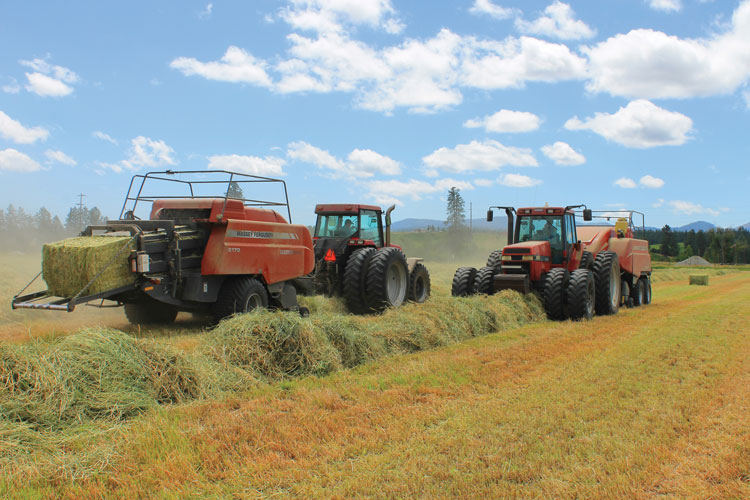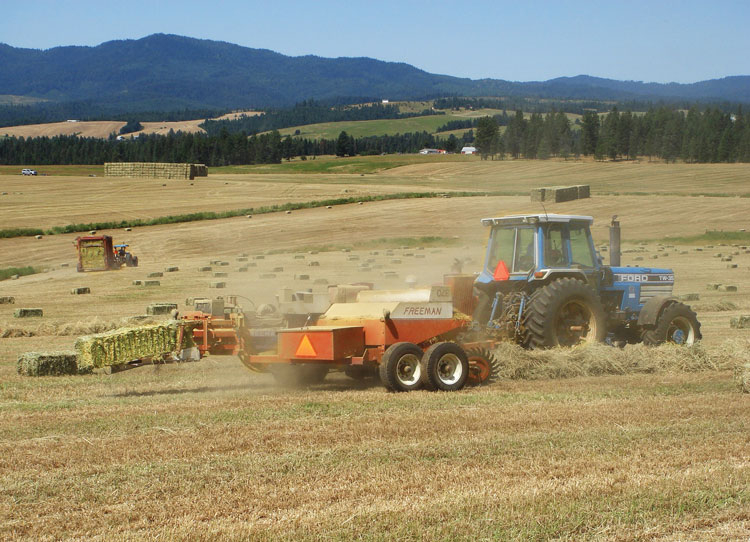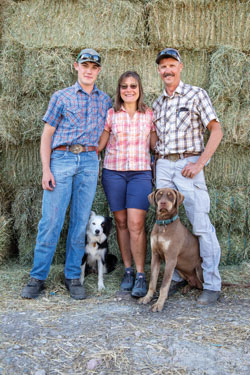
It's not Idaho’s Magic Valley, nor is it Washington’s fertile Columbia Basin. Rather, it’s the land in between, located on the western edge of Idaho in the far eastern Palouse region. Here, in Idaho’s Panhandle, is where Wade Simons and his wife, Edie, have built a successful farm business, leasing land that, by their own admission, “most farmers don’t want.”
Simons, who originally grew up on a small farm in northeast Washington, graduated from the University of Idaho-Moscow in 1996 with an agricultural engineering degree. Not finding a job that fit him out of college, he started working for a nearby farmer that he had become acquainted with during college. His new employer was one of the first in that area to grow timothy for the export market. Simons’ work at the farm and his hands-on schooling on timothy production would shape the rest of his farming career.
“After three years as an employee, I set out on my own and bought a Freeman 330 baler with a Wisconsin engine that was older than I was,” Simons remembered. “Initially, I started doing custom baling and took some part-time truck driving jobs hauling hay for the export market or to dairies and feed stores in western Washington. I borrowed a late 1960’s John Deere tractor from my dad and made 38,000 bales that first summer.”
Before the second year of self-employment, Simons added another baler and a stacker. “From that point, we just kept picking up land to rent, sharecropped some, and lived like paupers,” he recalled of those early years. “I knew my numbers and was sure it would work if I kept enough volume, but it was a slow growth process.”
Wade married Edie in 2003 and they bought a 118-acre farm near Princeton, Idaho, in 2006, where they reside today. “At that point, we were farming about 800 acres of leased or sharecropped land and still doing some custom work.”
Currently, Simons farms about 2,300 acres of mostly leased land that’s located from just north of Palouse, Wash., to Harvard, Idaho, a west-to-east span of about 20 miles. The Western fields are more productive than those to the east. “We spend a lot of time on the road,” Simons noted.
A timothy pioneer
Simons Farms LLC grows and harvests about 1,100 acres of timothy for exporting. This is done with the help of Edie, who helps with fieldwork, their 18-year-old son, Chet, one fulltime employee, and several part-time workers. Like his first employer out of college, Simons was one of the pioneers in the area to successfully grow the cool-season grass for the export market.
To break the hay rotation, the Simons also grow spring and winter wheat, barley, garbanzo beans, peas, and canola. “We shoot for about a 10-year rotation,” Simons said. “Ideally, seven of those years will be timothy, and then we go to one of the other rotation crops for three years, depending on the location of the field. For example, we don’t do legumes in some fields because the elk and deer just decimate those crops,” he added.

“Timothy has only become a viable crop in northern Idaho in the last 20 years,” the veteran grower said. “Now, there’s about 34,000 acres of timothy in this region. I just happened to work for one of the first to grow it and continued to do so once I got on my own.”
Simons continued, “Our timothy comes off two to three weeks later than that of growers in the Columbia Basin. So, that makes for an interesting market dynamic. If they have a good crop, that’s worse for us from a market price perspective. However, if their crop is down in either yield or quality, we can benefit.”
Simons harvests his export timothy as 3x4x8-foot bales that are made with two Massey Ferguson (MF) balers. “We like to ship directly out of the field to the exporter in Moses Lake or Ellensburg, Wash., so tarping is something we don’t have to do very often,” Simons explained. “The exporters like to keep it in the Columbia Basin because there’s a lot less rain to deal with during storage than here. Most of the timothy goes to Japan for their dairies.”
In addition to timothy, the Simonses also grow 350 acres of mixed-grass hay and about 40 acres of alfalfa, which are packaged into three-tie bales using three Freeman balers. The bales are picked up in the field with a Freeman 7000 stacker. “It’s a pull-type stacker that works really well on our steep hills when used with a four-wheel drive tractor,” Simons noted.
The farm’s alfalfa fields are cut two times per year and average 3 to 3.5 tons per acre annually. The alfalfa and mixed-grass production is marketed locally to horse owners, stables, and for livestock at Washington State University in nearby Pullman. Certified weed-free straw is also produced and sold for roadway mulch and to the Forestry Service.
Low moisture needed
Simons has seeded timothy both in the late fall and spring, but recently has favored the latter to avoid winter annual weed problems. He uses different timothy varieties that vary in maturity and plans it so he can start with his western-most fields and work east into Idaho. This lengthens his harvest window.
Timothy fields receive phosphorus and potassium fertilizer in the fall as guided by soil tests. Nitrogen and sulfur are applied each spring. “We generally start cutting timothy the end of June, and that’s the only cutting we get for the year,” Simons said. “None of our ground is irrigated.” The region gets about 23 inches of precipitation each year, but little of that total falls during the summer.
Using a 16-foot MF rotary mower-conditioner, Simons drops a wide swath, which expediates drying. The crop is then raked once with a MF RK772 rotary rake. In good years, he will harvest 4 tons of timothy per acre with a single cutting, but his average is 3 to 3.5 tons per acre. Any timothy regrowth by fall is cut off with a rotary mower to prepare for the next year’s crop.

Even for timothy, Simons likes to bale in the evenings or early morning before the crop dries too much. “It just makes a lot better bale, and you don’t get as much shattering,” he explained. “For export timothy, we have to stay at 12% moisture or less. I like the 10% to 12% range. We try to get it bone dry and then bring the moisture back up with a little bit of dew,” he added.
“In 2022, our quality was down, and everything was ready at once because we had to wait out the rain and cool weather in June,” Simons noted with frustration. “Brown leaf disease was a real problem, but we had good yields.”
For the Simonses, success has been achieved by being early adopters on a road less traveled. That road has resulted in becoming a proficient timothy grower — on fields nobody else wants — in a region not blessed with the greatest soils, flattest fields, or longest growing season, which are attributes common among many the Simonses production competitors. Once again, we’re reminded that a winning hand often lies with the individual, not the cards they’ve been dealt.
This article appeared in the April-May 2023 issue of Hay & Forage Grower on pages 6-7.
Not a subscriber? Click to get the print magazine.

